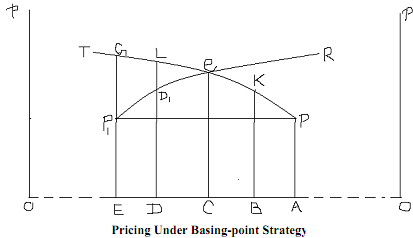Basing-point Price System:
Basing-point pricing has been adopted often in practice by oligopolists producing a homogeneous product whose transportation costs are relatively higher and whose production requires a large plant, if full economies of scale (minimum production costs) are to be realised. We would consider two kinds of basing-point pricing - single basing-point and multiple basing-point system.
Single Basing-point System
In this collusive pricing model, the oligopolists agree on a common place as the basing-point, and all the firms set the price as the production price (mill price) at the basing-point plus the transport cost from the basing-point to the place of destination. This is shown in the following Figure.

Let town A be the basing-point for all oligopolists located anywhere. The basing-point production price = AP. Delivered price increases as the distance from the basing-point increases. Let us assume that the delivered prices change as shown by curve PT in Figure. These prices are the same for all the oligopolists.
Therefore, a firm located in town E will quote the price EG to its local customers, DL to customers in town D, BK to buyers located in town B. If the production price (mill price) is, in town E, the same as in the basing-point A, the firm in E will be realising excess profits by selling to buyers located between E and C. For example, if the firm in E sells to a buyer located in D, the firm will be making an excess profit equal to D1L per unit of output, since its freight costs are given by the P1R curve. Such excess profits are called 'phantom freights'. The firm in E may expand its sales beyond point e in the territory-market of firms located at A, if its marginal costs are less than its mill price EP1 minus the freight it will have to cover.
i.e., MC ≤ EP1 - freight cost
or, MC + freight cost ≤ EP1 (mill price), so that the oligopolist is still making some profit.
The oligopolists may find it profitable to sell in each other's territory-markets. This is known as cross-hauling.